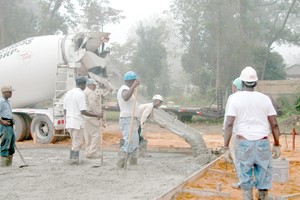Holcim, a leading construction materials company, has spearheaded a groundbreaking project in Switzerland, introducing the country's first onsite 3D concrete-printed building. Completed within a remarkable eight days, this innovative endeavor represents a paradigm shift in construction methodologies, promising not only enhanced design flexibility but also significant time, cost, and material savings, along with notable sustainability benefits.
In collaboration with Kobelt AG, a forward-thinking construction firm, Holcim embarked on constructing a showroom pavilion to accommodate the burgeoning needs of Kobelt's operations. Rather than opting for traditional expansion, Kobelt's board of directors chose to erect a new space on their existing office grounds, signaling a commitment to innovation and environmental responsibility.
Kevin Böhlen, Project Manager at Holcim Switzerland, underscores the significance of this venture, emphasizing the fusion of beauty, efficiency, and sustainability. The design of the showroom, characterized by clear facets and fan-shaped steel supports, is crowned by a wing-shaped roof crafted from multi-layered wooden panels, showcasing Kobelt's expertise in architecture and construction.
Central to this project is Holcim's cutting-edge 3D concrete printing technology, which enables the layer-by-layer application of specialized concrete without the need for traditional formwork. Leveraging digital 3D models, this process streamlines construction, optimizing both time and resources. For the showroom pavilion, a COBOD printer was employed, utilizing a specially formulated concrete renowned for its strength and reduced environmental impact, owing to its lower cement content and utilization of locally sourced sand and gravel.
The sustainability advantages of 3D concrete printing are manifold. By empowering intelligent design, this method can slash material usage by up to 50%, delivering structures that are both efficient and resilient. Moreover, 3D-printed walls contribute to reducing carbon footprints, as evidenced by the Phoenix Bridge project, where a proprietary low-carbon concrete formulation achieved a 25% reduction in overall carbon emissions. Furthermore, 3D printing facilitates circular construction principles, promoting resource conservation through easily disassembled and recyclable building components.
Kevin acknowledges the challenges encountered during the project's execution but underscores the invaluable insights gained to refine future workflows. Gratitude is extended to all contributors and supporters, with special recognition for Kobelt AG's confidence in pioneering this groundbreaking initiative.
The completed pavilion spans approximately 150 m² and stands at a height of 6.2 meters, with a total length of printed material reaching an impressive 27 kilometers. Beyond this singular achievement, Holcim remains committed to advancing sustainability, efficiency, and safety across the construction industry, continuously exploring innovative technologies along the entire value chain.
In essence, Holcim's pioneering endeavor not only redefines what is possible in construction but also exemplifies a concerted effort towards a more sustainable and resilient built environment.













